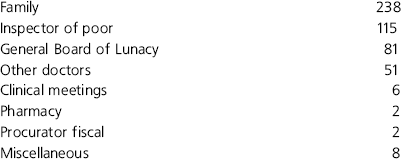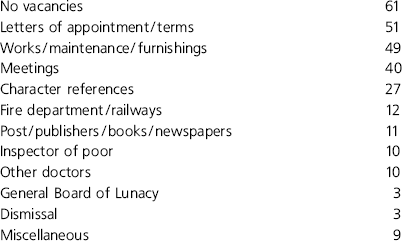The mythology of 19th-century asylums portrays them as dark and inhuman gothic institutions. Historical research is beginning to shed new light onto this world, however, forcing us to re-examine long-held beliefs. Case note analyses have consistently shown high levels of psychiatric morbidity in the patients admitted to these institutions (Reference TurnerTurner, 1992; Reference BeveridgeBeveridge, 1995; Reference Doody, Beveridge and JohnstoneDoody et al, 1996). Patients' letters have been examined and confirm high levels of florid psychopathology (Reference BeveridgeBeveridge, 1997), they also reveal some aspects of the rich social and cultural life available to patients at the Royal Edinburgh Asylum. Such studies add to our understanding of the culture of mental hospitals described by Jones (Reference Jones, Berrios and Freeman1991).
The day-to-day working life of 19th century physician superintendents remains ill-defined, however. Biographies of illustrious academics such as Henry Maudsley (Reference Turner, Bynum, Porter and ShepherdTurner, 1988) and reformers such as John Conolly (Reference Scull, Bynum, Porter and ShepherdScull, 1985) often fail to give a sense of the routine clinical and administrative work that underpinned their careers. Contemporary Medico-Psychological Association presidential addresses referred to the excessive workload of asylum doctors and suggested that this acted as a disincentive to recruitment (Reference NormanNorman, 1894). This stemmed from the all pervading responsibility for patients combined with the mundane and trivial nature of many of their tasks (Reference Hayes NewingtonHayes Newington, 1889). Charles Mercier (Reference Mercier1894) suggested a timetable for superintendents that set aside 90 minutes a day for administrative work, though it is not known to what extent this timetable was followed by other physician superintendents.
The purpose of this study was to examine in detail the correspondence book of a physician superintendent at a Scottish pauper asylum. In particular, the contents of the letters were analysed to shed light on conditions for patients and staff in an asylum in its opening year.
Historical background
In 1888 a District Lunacy Board was formed for Lanarkshire that was to oversee the planning, building and eventual running of the new Lanark District Asylum (from the earliest days more commonly referred to as Hartwood Asylum). It was designed by a local architect with “the buildings… plainly and very substantially built… all architectural decoration having been kept subsidiary to the grouping of the buildings for the efficiency and convenience of administration” (The Herald, 11 May 1895). The cost of the project, which had a capacity of 500 beds, was £152 430 with a further £ 10 000 being spent on furnishings. The staff complement comprised three doctors, six administrative staff, 25 male attendants, 17 female nurses, 12 servants and seven artisans and tradesmen. Hartwood grew rapidly and by 1901, when Campbell Clark (its first physician superintendent) died, it housed 730 patients, of whom 44 were private.
Rising from humble beginnings to become one of the most influential of 19th-century Scottish psychiatrists, Campbell Clark was born in Lochgilphead in 1852 where he worked in an administrative capacity in the local asylum. He went on to work in a Glasgow warehouse before studying medicine in Edinburgh. He worked as an assistant to Thomas Clouston at the Royal Edinburgh Asylum before taking up the position of physician superintendent at the Glasgow District Asylum in Bothwell, which took patients from some Glasgow and Lanarkshire parishes. While carrying out his duties in this post he worked exhaustively to establish the new county asylum for the whole of Lanarkshire.
His obituary described him as a man who “worked incessantly and at high pitch, whatever he did he did with his whole might” (JTM, 1902). He published extensively throughout his career, including case studies (Campbell Clark, Reference Campbell Clark1879, Reference Campbell Clark1888, Reference Campbell Clark1899) and clinical research into puerperal insanity (Campbell Clark, Reference Campbell Clark1883, Reference Campbell Clark1887/8), dietetics (Reference Campbell ClarkCampbell Clark, 1887) and treatment with extract of spleen (Reference Campbell ClarkCampbell Clark, 1898). He was appointed McIntosh Professor of Psychological Medicine at Glasgow University and published a popular textbook The Clinical Manual of Mental Diseases (Reference Campbell ClarkCampbell Clark, 1897).
Perhaps his greatest and most lasting contribution, however, was in the training and welfare of attendants and nurses (Campbell Clark, Reference Campbell Clark1884a , Reference Campbell Clark b , Reference Campbell Clark1886, Reference Campbell Clark1894). He was one of the earliest physician superintendents to suggest that patient care would benefit from improvements in the training of attendants and nurses. He instituted a series of lectures for staff who had hitherto been looked down on as ruffians and servants. With Drs McIvor Campbell, Turnbull and Urquart he was commissioned by the Medico-Psychological Association to produce a compilation of these lectures to help attendants “to a due understanding of the work in which they were engaged”: The Handbook for the Instruction of Attendants on the Insane (Reference Campbell ClarkCampbell Clark, 1885) as this became was known affectionately as ‘the little red book’ and was in use in subsequent editions until the 1980s (Reference RollinRollin, 1986). Despite his pivotal role in the development of both mental health nursing and industrial therapy, Campbell Clark has not been afforded his due significance by writers on the history of nursing (Reference Nolan, Freeman and BerriosNolan, 1996) or occupational therapy (Reference Bennett, Freeman and BerriosBennett, 1996).
The study
Among the archives of Hartwood Hospital is a volume of copies of letters from 1895 written in longhand by Campbell Clark (typed, later in the year) or his assistant medical officers. The volume starts with the appointment letters of key staff some 3 weeks before the asylum opened. It spans just over a year and contains a total of 1500 letters.
All letters from 1895 were examined and a 16-item checklist completed. Legibility and authorship were noted as well as content. This was divided into administrative, clinical and personal. Other contemporary records and secondary sources were examined to provide background historical material and to help understand the context of the letters.
Findings
A total of 863 letters were examined, of these 308 (36%) were administrative and date mainly to the weeks before the opening of the hospital (Table 1). A further 503 (58%) relate to clinical matters (Table 2). The majority of letters were written by Campbell Clark himself, 131 (15%) were written by his assistant medical officers. Only eight (1%) letters were personal and 44 (5%) were illegible.
Table 1. Administrative letters (n=308)

| No vacancies | 61 |
| Letters of appointment/terms | 51 |
| Works/maintenance/furnishings | 49 |
| Meetings | 40 |
| Character references | 27 |
| Fire department/railways | 12 |
| Post/publishers/books/newspapers | 11 |
| Inspector of poor | 10 |
| Other doctors | 10 |
| General Board of Lunacy | 3 |
| Dismissal | 3 |
| Miscellaneous | 9 |
Table 2. Clinical Letters (n=503)

| Family | 238 |
| Inspector of poor | 115 |
| General Board of Lunacy | 81 |
| Other doctors | 51 |
| Clinical meetings | 6 |
| Pharmacy | 2 |
| Procurator fiscal | 2 |
| Miscellaneous | 8 |
Administrative letters
The first letter is addressed to the matron who was appointed with a salary of £70 per annum with furnished apartment, board and laundry. A medical assistant was appointed with a salary of £100 per annum. There was a great deal of interest in working at the asylum and Campbell Clark turned down 61 applicants for a range of positions.
Twenty-seven letters requesting references attest to the care with which he made his appointments. An ability to play a musical instrument was a useful skill for applicants. He aimed for a staff to patient ratio of 1:10. When staff left for reasons he considered frivolous, he wrote to superintendents at other hospitals advising them not to employ them. Prior to the opening in May, Campbell Clark had to make arrangements for the train to stop to drop off mail twice per day. He also requested the times of trains be changed to coincide with changes of duty. A number of letters relate to fire safety and water quality.
Clinical letters
Two hundred and thirty-eight of the clinical letters were to family members informing them of the progress of patients, giving visiting times or inquiring into the history of the illness, family etc. He was keen to develop amusement and recreation for his patients and advocated 2-3 hours of outdoor exercise per day for female patients. Transfers of patients from other asylums were carefully planned and he was keen to ensure that patients were fit to travel. Patients dying in suspicious circumstances were fully investigated. Campbell Clark believed strongly in the therapeutic value of work and patients often underwent periods of rehabilitation with industrial therapy prior to discharge.
Personal letters
Campbell Clark appeared to enjoy whisky and wrote to a number of distilleries for free samples. He seemed to enjoy a good working relationship with the Chairman of the District Lunacy Board, to whom he sent regular cases of whisky. Although he worked most weekends he found occasional time to relax: on a trip to the theatre in Edinburgh he lost his appointments diary and wrote asking them to return it.
Discussion
The content of the letters reveals the extent of a physician superintendent's responsibilities: it was Campbell Clark's job to ensure the water was drinkable, the trains stopped on time, the staff were suitable and the patients were occupied or entertained. The study confirms the high administrative and clinical workload described by senior 19th century psychiatrists. Red tape, bureaucracy and an unmanageable administrative workload are often cited as a cause of stress and early retirement by psychiatrists working today (Reference Kendell and PearceKendell & Pearce, 1997). That these stresses existed 100 years ago suggests a failure by the profession to manage these demands satisfactorily. The correspondence also reflects Campbell Clark's commitment to the training and welfare of attendants and nurses and his family- and community-oriented approach to the care of the ‘insane’ in the nineteenth century. As the centenary of his death approaches it is timely to re-examine his philosophy and approach to psychiatry, which anticipated many later developments.
Acknowledgement
We thank Julian Hodgson, Librarian, for his help in obtaining source material.





eLetters
No eLetters have been published for this article.